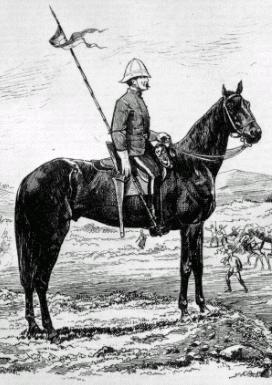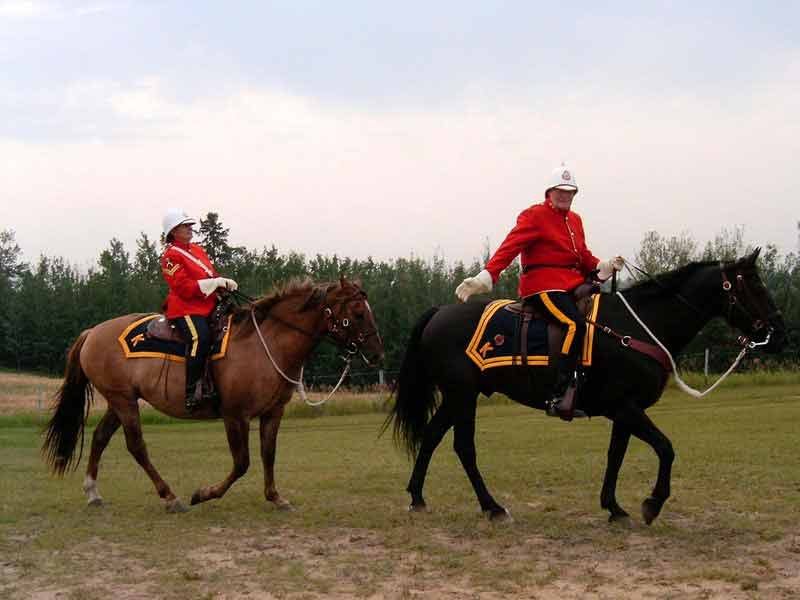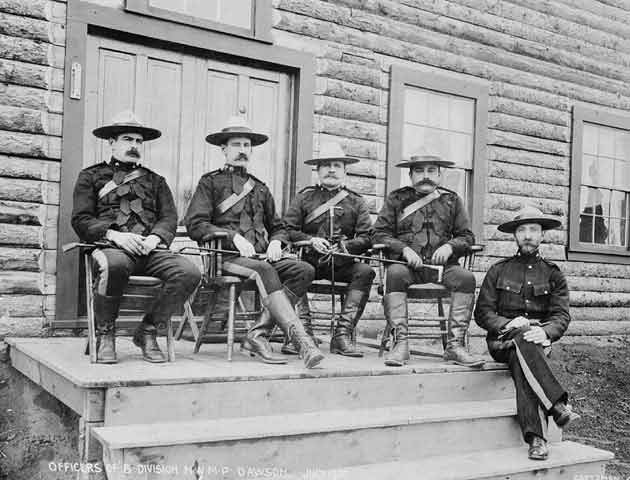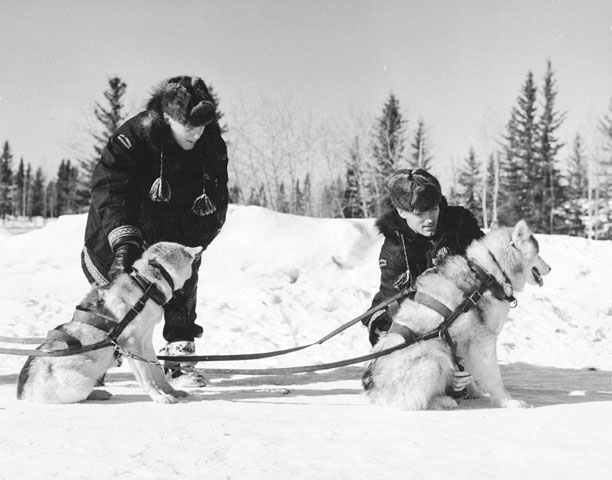Mounties
The Royal Canadian Mounted Police (RCMP or Mounties; French, Gendarmerie royale du Canada, GRC) is both the federal police force and the national police of Canada. The RCMP provides federal (national) police services. It also provides, under contract, provincial and municipal police services to Canada's three territories and eight of its provinces (with the exceptions of Ontario, Quebec, and parts of Newfoundland and Labrador). (Most of Canada's provinces, while constitutionally responsible for law and order, prefer to sub-contract policing to this professional national force that consequently operates under their direction in regard to provincial and municipal law enforcement.) The RCMP is the largest police force in Canada; as of April 2004, the RCMP had an on-strength establishment of 22,239 personnel.
The RCMP are famous for their distinctive Red Serge, a scarlet ceremonial uniform with a stetson hat with a wide flat brim, and the Musical Ride. The Musical Ride is a ceremony in which officers showcase their horse riding skills and uniform in the execution of a variety of intricate figures and cavalry drills with music. On normal duties, the RCMP uses standard police methods, equipment, and uniforms. Horses are no longer used operationally by any unit.
It has been theorized that the international popularity of the force lies in it being representative of a symbol of the balance of civilization and the frontier. That is, the RCMP is a police force that operates in the seemingly wild frontier, but operates under the behest of a central, if somewhat removed, bureaucratic authority back in the settled regions. In addition, the existence of the RCMP in Canada and the complete lack of any analogous organization in the Western United States during the frontier period has often been cited as both a cause and effect of cultural differences between Canada and the United States.

The RCMP was created as the North West Mounted Police on May 23, 1873 by Sir John A. Macdonald, the first prime minister of Canada, with the intent of bringing law and order to (and asserting Canadian sovereignty over) the North-West Territories (which then included modern day Alberta and Saskatchewan). This need was particularly urgent with reports of American whisky traders, in particular those of Fort Whoop-Up, causing trouble in the region, culminating in the Cypress Hills Massacre. The force was initially to be called the North West Mounted Rifles, but that was rejected as too military in nature, Macdonald fearing that this could antagonize both the First Nations and the Americans. Acting on a suggestion in his cabinet, Macdonald had the force wear red uniforms, both to emphasize the British nature of the force and to differentiate it from the blue American military uniforms. The force was organized like a British cavalry regiment and still maintains some of the traditions of those units, like the Musical Ride, to this day.
The Red Serge tunic that identified initially the NWMP, and later the RNWMP and RCMP, is of the standard British military pattern. The NWMP was originally kitted out from militia stores, resulting initially in several different styles of tunic, although the style later became standardized.
Initially the NWMP wore buff trousers. Later dark blue trousers with yellow-gold strapping (stripes) were adopted. Members of the NWMP were known to exchange kit with US cavalry units along the border and it is suggested that this was the initial source for the trousers; however, blue trousers were considered early on, although with a white strap. Dark blue with yellow-gold strapping is another British cavalry tradition, and Canadian city police forces frequently wear dark blue trousers with a narrow red strap of infantry tradition.

North West Mountain Police (reenactors).
The wide flat brim stetson hat was not adopted officially until about 1904. Although the NWMP contingent at Queen Victoria's Diamond Jubilee wore the stetson, it was an unofficial item of dress. The primary official head dress at the time was the white British foreign service helmet, also known as a pith helmet. This was not particularly practical as headdress in the Canadian west, and members wore a stetson type hat on patrol and around camp. Sam Steele is often credited with introducing the stetson-type hat, and when he left the force to command Lord Strathcona's Horse and took the regiment to South Africa he also adopted the stetson for this unit.
Black riding boots were later changed to the modern brown style. The original crossbelts were later changed to the brown Sam Brown type currently worn. Sidearms are standard now, but were often not worn in the early years.
The NWMP's early activities included containing the whisky trade and enforcing agreements with the First Nations peoples. To that end, the commanding officer of the force arranged to be sworn in as a justice of the peace, which allowed for magisterial authority in the Mounties' jurisdiction. In the early years, the force's dedication to enforcing the law on the First Nations peoples' behalf impressed them enough to encourage good relations. In 1885, the NWMP helped to quell the North-West Rebellion led by Louis Riel.
In 1895, jurisdiction was extended to the Yukon during the Klondike gold rush, where the force served with distinction under the command of Sam Steele, making the gold rush one of the most peaceful and orderly such affairs in history. Ironically, the force's dissolution was being discussed around this time in Parliament, but the Mounties' conduct so impressed the prospectors during the gold rush that the force became famous around the world and their survival was ensured.
In 1903 jurisdiction was extended to the Arctic coast, and in 1912 to northern Manitoba.
During the Boer War, the force raised the Canadian Mounted Rifles, mostly from NWMP members, for service in South Africa. For the CMR's distinguished service there, Edward VII honoured the NWMP by changing the name to the Royal North West Mounted Police on June 24, 1904.
On February 1, 1920 the RNWMP was merged with the Dominion Police and was renamed the Royal Canadian Mounted Police, with responsibility for federal law enforcement in all provinces and territories.

Royal Canadian Mountain Police, Yukon Territory, 1900
In 1919 the RCMP was used to repress the Winnipeg General Strike, when officers fired into a crowd of strikers, killing two and causing injuries to thirty others.
In 1935 the RCMP, collaborating with the Regina city police, crushed the On-to-Ottawa Trek, which had been organized to call attention to the need for decent treatment of the unemployed men in the relief camps.
The acquisition of the RCMP schooner St. Roch facilitated the first effective patrol of Canada's Arctic territory. It was the first vessel to navigate the Northwest Passage from west to east (1940-1942), the first to navigate the Passage in one season (1944), and the first to circumnavigate North America (1950).

Royal Canadian Mounted Police patroling by dog sled, 1957
In the 1920s, the RCMP assumed responsibility for national counter-intelligence, which they retained for decades. However, by the late 1970s, it was discovered the force had in the course of their intelligence duties engaged in crimes such as burning a barn and stealing documents from the separatist Parti Québécois, among other abuses. This led to the McDonald Commission - Royal Commission of Inquiry into Certain Activities of the RCMP, better known as the "McDonald Commission", named after the presiding judge, Mr Justice David Cargill McDonald (died 1996). The Commission recommended that the force's intelligences duties be removed in favour of the creation of a separate intelligence agency, the Canadian Security Intelligence Service (CSIS).
On March 3, 2005, four RCMP officers were killed on a farm near Mayerthorpe, Alberta during an operation to recover stolen property, and investigate an illegal marijuana grow-op. Only the North-West Rebellion (1884-1885) saw more police lives lost in one incident in Canadian history than the Rochfort Bridge massacre.
Among themselves, the Mounties universally refer to their organization as "The Force" and members of the force are referred to as "Members."